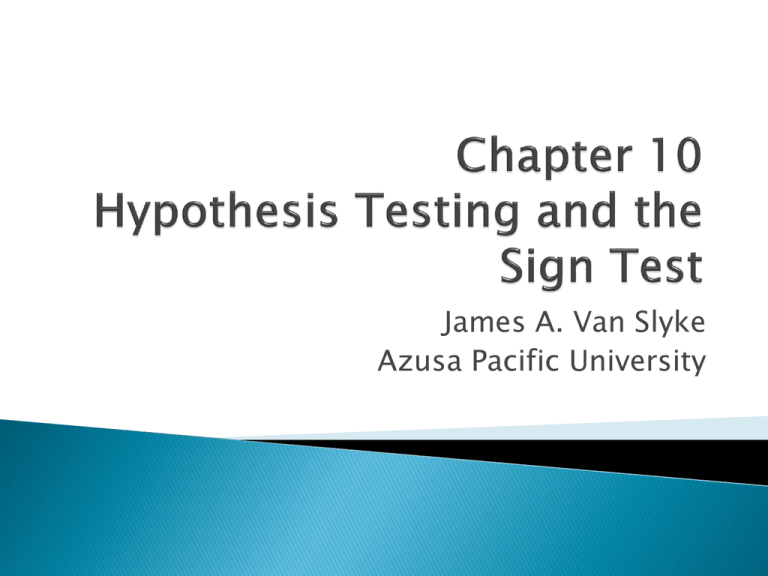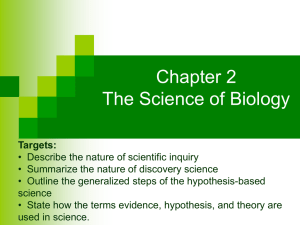Chapter 10 - Hypothesis Testing + Sign Test
advertisement

James A. Van Slyke Azusa Pacific University Purpose – ◦ Allows a scientist to test the influence of the independent variable upon the dependent variable ◦ Controls for the influence of other variables Conclusions ◦ Primary question – “How reasonable are these results if chance alone were responsible?” ◦ If the results are not due to chance, then the results are attributed to the experimental manipulation Repeated Measures Design ◦ One of several commonly used designs ◦ Replicated Measures Design or Correlated Groups Design Subjects are paired prior to conducting experiment Difference between paired scores is analyzed Two Experimental Groups ◦ Experimental – Receives treatment ◦ Control Group – No Treatment (placebo) Alternative Hypothesis (H1) ◦ Claims that difference in results between the two conditions is due to the independent variable Directional Hypothesis ◦ Specifies the direction of the effect of the independent variable Nondirectional Hypothesis ◦ The independent variable has an effect but the direction is not specified Logical counterpart of alternative hypothesis ◦ Nondirectional – the independent variable has no effect on the dependent variable ◦ Directional – the independent variable has no effect in that specific direction on the dependent variable The alternative hypothesis and the null hypothesis are mutually exclusive and exhaustive If one is true the other must be false and vice versa The experiment attempts to show that the null hypothesis is false Obviously if the null hypothesis is false, the alternative hypothesis can be accepted as true The null hypothesis is evaluated directly because it is possible to calculate the probability of chance events But, there are no mathematics for the alternative hypothesis The focus in on the null hypothesis to support accepting the alternative hypothesis Chance – the probability of the results is compared to that of chance Alpha level – If the probability is less then or equal to the value of alpha, the null hypothesis is rejected When the null hypothesis is rejected, the results are thought to be significant or reliable Level of alpha is dependent upon the particular experiment A lpha level = C om m on levels for alpha 0.05 0.01 Type I – Null hypothesis is rejected when it is actually true ◦ Probability of Type I error set by alpha Type II – Null hypothesis is retained when it is actually false ◦ Probability of making a Type II error is called beta Increasing alpha decreases beta and vice versa Setting alpha and beta depends upon the cost of making either type of error Directional Hypothesis – determine the probability of getting an outcome or an even more extreme score ◦ Evaluate the tail of the distribution Nondirectional hypothesis – probability of obtaining an extreme score in both direction ◦ Evaluate both tails of the distribution Two-tailed probability – without valid basis for directional hypothesis, indirectional used One-tailed probability – Used for directional hypothesis ◦ If there is a good theoretical basis ◦ If there is other data supporting the conclusion Used only in replicated measures ◦ 1. Null and alternative hypothesis generated ◦ 2. Directional or nondirectional ◦ 3. Alpha level set Difference between control group and experimental calculated ◦ ◦ ◦ ◦ Sign of the difference recorded Magnitude of difference ignored Ties are ignored Assumptions of binomial distribution must be present Calculate ◦ Probability of getting results and more extreme results ◦ Use one or two-tailed binomial distribution depending on hypothesis ◦ Compare probability to alpha Draw appropriate conclusions and generalizations Results that are statistically significant are reliable Yet statistically significant does not mean a large effect Effects are dependent upon their particular size and their reliability 4, 5, 7, 9, 10







